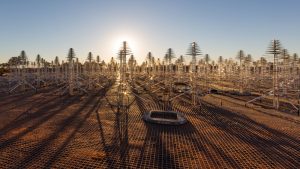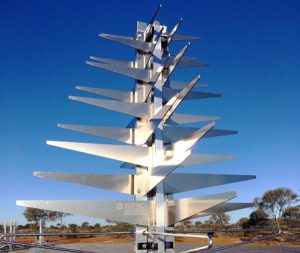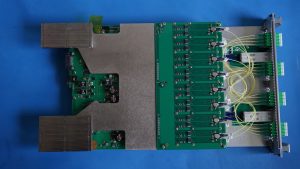
A. The first SKAlow complete station consisting of 256 antennas
The Square Kilometre Array (SKA) project is an international effort to build the world’s largest radio telescope. With hundreds of thousands of antennas installed in Australia and South Africa, SKA will provide unprecedented sensitivity and observing speed in the radio band. Italy is one of the 13 countries that joined the SKA Organisation. IRA personnel are involved in the design and production of SKA, and in all its scientific cases: from cosmology to magnetism and general relativity, from the evolution of galaxies to the detailed study of our Galaxy.
To know more on SKA visit the official international SKA website and the Italian SKA website.
Staff: R. Baldi, G. Bernardi, G. Brunetti, R. Cassano, A.Cattani, F.Fiocchi, D. Guidetti, A. Mattana, J. Monari, G. Naldi, F. Perini, M. Poloni, I. Prandoni, G. Pupillo, S. Rusticelli, M. Schiaffino, A. Tabellini, T. Venturi
The SKAlow project

B. The first complete SKAlow station, consisting of 256 antennas
Skalow is the SKA low-frequency component. The prototype systems were installed at the Murchison Radio Astronomy Observatory (MRO), in Western Australia, to perform observations between 50 and 350 MHz. In its complete configuration a few kilometers from MRO, SKAlow will be made up of almost 130,000 antennas, which will produce a amount of data equal to five times the global Internet traffic. SKAlow will allow the study of one of the most interesting periods of the universe, observing its first billion years of life and providing precious information on the formation of stars and galaxies, on dark matter and dark energy. The Italian team involved in the SKAlow project is led by IRA and includes scientists and engineers from various national research bodies/institutes, such as the Arcetri Astrophysical Observatory, Catania Astrophysical Observatory, Institute of Space Astrophysics and Cosmic Physics of Milan, the Universities of Bologna and Florence, the Institute of Electronics, Computer and Telecommunication Engineering (IEIIT) of the National Research Council and the Politecnico di Torino.
Within the SKAlow project, Italy led the development of analog receivers with optical technology and played an essential role both in the development of acquisition systems for the analog-digital conversion of radio signals and in the construction and installation of AAVS1/ 2 (Aperture Array Verification System 1/2), consisting of antennas ranging from the “SKALA2” generation, designed and produced by the University of Cambridge, up to the current prototype conceived and made in Italy, the “SKALA4.1 AL” design baseline for SKAlow. INAF also provided the receiving systems for EDA2 (Electronic Demonstrator Array 2), an array composed of dipoles equal to those used in the SKA precursor Murchison Widefield Array.
Antennas and Receivers

C. Detail of the SKALA4.1 antenna
SKALA 4.1 AL is the name of the current prototype of antennas installed in AAVS2. It has been developed by INAF in collaboration with IEIIT and the Italian company Sirio Antenne, starting from the SKALA4 electromagnetic design of the International consortium Aperture Array Design Construction. SKALA 4.1 AL is a Christmas tree-like, log-periodic and double polarization antenna which ensures a large receiving band. The Italian team worked also to the development of a low noise amplifier (LNA), in collaboration with the Koreana ASB company, which is installed on the top of the antenna to amplify the weak astronomical signals. AAVS2 is the station comprising 256 SKALA4.1 AL antennas deployed in 2019 by IRA engineers and technicians at MRO, with the support of Australian colleagues. Since 2004 IRA is also been working to the design of low frequency (<2 GHz) receivers and introduced the so-called RFOF technology (RadioFrequency Over Fiber), which allows antennas to transport all the signals in a central structure and which has become a key element for AAVS2.
TPM: Tile Processing Module

D. Tile Processing Module 1.6 board
The IRA team has also led an International collaboration aimed at the creation of a digital/analog system for the acquisition and processing of radio signals (Tile Processing Module, TPM), developed in collaboration with the Italian companies Sanitas Eg, Elemaster, Optel, Protech and Leonardo. The collaboration has also developed a system based on the use of a drone (Unmanned Air Vehicle, UAV) for the testing of antennas. The UAV is equipped with a dipole-like transmission antenna and a satellite positioning system, which allow the team to verify the behavior of the SKAlow prototype antennas with great accuracy from a far away (hundreds of meters) position . The Italian team visited MRO several times to conduct measurement campaigns on these antennas, in collaboration with the University of Oxford/Malta and the Australian International Centre for Radio Astronomy Research.
Credits
Figures A, B: ICRAR/Curtin
Figures C, D: INAF-IRA
